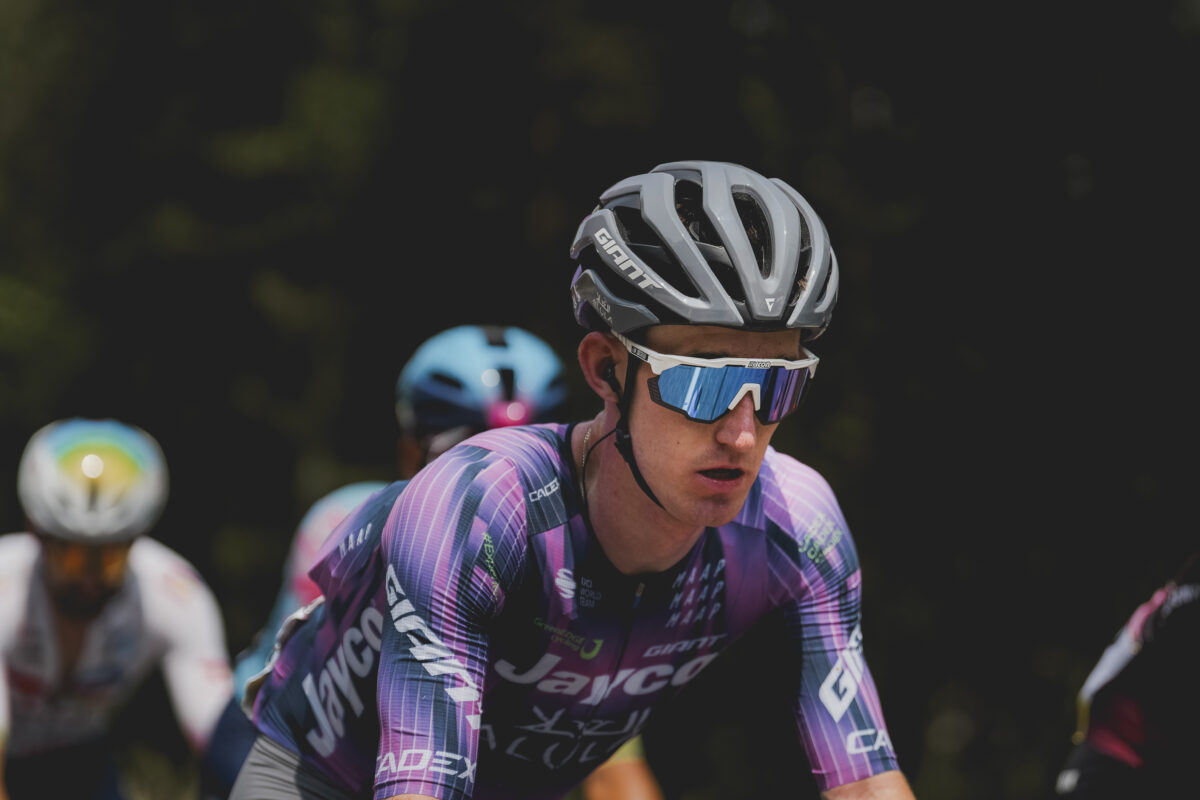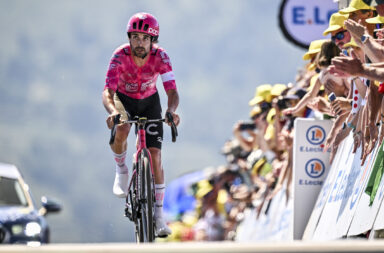
Having crashed out of the Tour de France, Eddie Dunbar (Team Jayco AlUla), has been reflecting on the ups and downs of his career, saying the crashes he has suffered in races have probably had an impact on him and the way he views racing.
However, he believes he now has time to bounce back after his Tour crash and perform at La Vuelta. He won two stages there last year, riding away from the favourites’ group on the Picón Blanco summit finish on the queen stage, having already won stage 11. He suggested he was in even better shape going into the Tour, which made crashing out harder to accept.
He revealed when he came down on stage 7 he instantly knew he might be in big trouble. He had to pop his thumb back into place in the moments after hitting the deck hard, after braking in a bid to avoid a crash just ahead of him.
“I knew pretty quick the chances of starting the next day were going to be fairly slim because of the way my hand was. It was like a balloon within five minutes,” he said, adding Geraint Thomas (Ineos Grenadiers) waited for him, which he “appreciated”.
“Being honest, I probably have more fear now than most cyclists, because of the injuries I’ve had. Any time I crash, it seems to be a big crash, something happens to me,” he told Off The Ball, full video below, adding he had often had to withdraw from races after a crash.
As a result, he believed he viewed races differently to other riders because falling at such high speed “changes the way you think… you don’t want to be hurt” no matter the rewards on offer. “I probably see a lot more fear than most of my competitors, which is maybe not a good thing sometimes,” he said.
🇫🇷 #TDF2025 📹
Eddie has to go home 🥹 Is Plappy really a West Australian? 🇦🇺 and Dylan looks forward to another crack at a sprint 💨 pic.twitter.com/kIry5QP6pt
— GreenEDGE Cycling (@GreenEDGEteam) July 12, 2025
While he hoped to “switch off from cycling” for now, it was hard to do that with the Tour on TV. But he would focus on preparing for the Vuelta by training on the home trainer from Monday. A big juncture would be getting more information about his injury and then undertaking the rehab and recovery he needed to.
The Vuelta was “always a good back-up” for any rider who crashed out of the Tour. If he could manage to repeat his exploits of last year, those would be good results and such an outcome would restore his confidence.
Before the Tour he explained he had two or three months of ideal training and racing, with altitude training and heat adadtation work, which had “paid off” for the Tour. He would now use his approach to the Tour as a “template” for the Vuelta. He had time to get to the Spanish Grand Tour in the same shape “and definitely be competitive”.
He felt while he could ride general classification in some races, in Grand Tours, stages would be the target, especially as he saw the impact on his life of winning the Vuelta stages last year. And though he’d made the breakaway on Tour stage 6 – finishing 4th as compatriot Ben Healy (EF Education-EasyPost) won – he was simply unable to contine after his stage 7 crash.
He finished the stage and got bandaged up and ready to race the following day, including getting into his racing kit at the start in Saint-Méen-le-Grand. But such was the pain in his left arm, he had to take the decision not to start, thus ending his debut Tour one week into the three-week race.
Dunbar said his wrist had swelled up severely after the crash, adding it was too painful to hold the handlebars, meaning he couldn’t brake. Aside from the pain, it would have been unsafe, for himself and the others in the peloton, if he had continued.
While X-rays immediately after the stage had not revealed any fracture, he said that with a hand or wrist injury, often an MRI or CT scan was required before a fracture in the hand would be spotted. He was now waiting for a specialist to assess further scans he had undergone since his withdrawal from the race.
While it was “great to see Ben (Healy) take the yellow jersey”, as he looked at the race on TV he could see riders he had been with on the stage 6 breakaway fighting for other stage wins. And that was “difficult to take”.
“I felt really good, I knew my condition going into it was vey good,” he said. “Obviously, it’s the Tour de France, you want to be at your best going into a race like that. It’s a massive event, I’d never done it before. You always hear how it’s so stressful, it’s bigger than the Giro or Vuelta.
“I was always curious to see what that was like and when you actually get to the race it’s incredible; the spectators that are there, just the amount of media there, it’s just bigger. With the condition I had, with the expectations I had, for sure it’s disappointing to be sat here.”
Of the crash itself, he said there was very little he could do when the riders ahead of him came down at such speed. He believed “very few bike riders would have got out of that situation” without falling.
However, one upside was that he did not hit his head, especially having previously sufferd from concussion. He said is wrist immediately “felt limp, it didn’t feel right” and he was in “excrutiating pain and I looked down and thumb didn’t look great”.
“A bit of the bone didn’t look great and I pressed on that and it popped back in. And that hurt. But after that there was immediate relief,” he said, adding he was “cut up” and it “took a while to process” falling at that speed. His bike was also “in two pieces”.
Dunbar added he had great admiration for Healy for taking a stage and the yellow jersey, adding he was one of the best riders at preparing for, and targetting, specific races and winning stages in so many races. He said before the start of stage 10, after he had gone home to Monaco, he felt certain Healy would have a big impact that day, which ended in him taking the yellow jersey.


